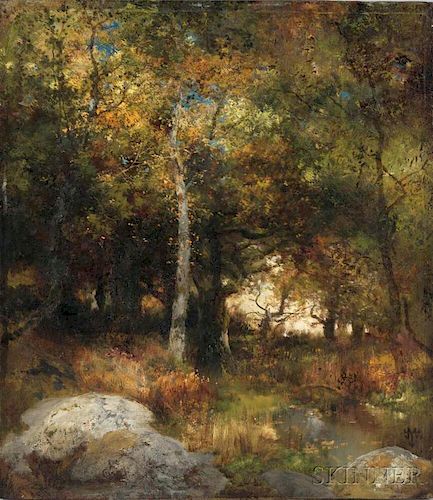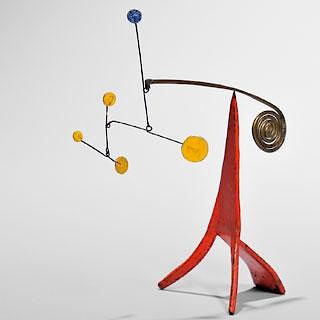Thomas Moran (American, 1837-1926) Autumn Woods
Lot 276
About Seller
Bonhams Skinner
274 Cedar Hill Street
Marlborough, MA 01752
United States
Founded over four decades ago, Bonhams Skinner offers more than 60 auctions annually. Bonhams Skinner auctions reach an international audience and showcase the unique, rare, and beautiful in dozens of categories, including the fine and decorative arts, jewelry, modern design, musical instruments, sc...Read more
Categories
Estimate:
$70,000 - $90,000
Absentee vs Live bid
Two ways to bid:
- Leave a max absentee bid and the platform will bid on your behalf up to your maximum bid during the live auction.
- Bid live during the auction and your bids will be submitted real-time to the auctioneer.
Bid Increments
| Price | Bid Increment |
|---|---|
| $0 | $10 |
| $100 | $25 |
| $500 | $50 |
| $1,000 | $100 |
| $3,000 | $250 |
| $5,000 | $500 |
| $10,000 | $1,000 |
| $30,000 | $2,500 |
| $50,000 | $5,000 |
| $100,000 | $10,000 |
| $300,000 | $25,000 |
| $500,000 | $50,000 |
| $1,000,000 | $100,000 |
About Auction
By Bonhams Skinner
Jan 27, 2017 - Jan 28, 2017
Set Reminder
2017-01-27 16:00:00
2017-01-28 16:00:00
America/New_York
Bidsquare
Bidsquare : Fine Paintings & Sculpture
https://www.bidsquare.com/auctions/skinner/fine-paintings-sculpture-2062
Bonhams Skinner bidsquare@bonhamsskinner.com
Bonhams Skinner bidsquare@bonhamsskinner.com
- Lot Description
Thomas Moran (American, 1837-1926)
Autumn Woods, alternately titled Yosemite Landscape
Monogrammed "TM" l.r., titled in pencil on a fragmentary label on the reverse, identified on a label from Spanierman Gallery, New York, on the frame backing, and with an alternate title on a label from Fenn Galleries Ltd., Santa Fe, on the reverse.
Oil on panel, 14 x 12 1/4 in. (35.3 x 31.0 cm), framed.
Condition: Fine stable craquelure, subtle frame abrasion.
Provenance: Sloan and Roman Gallery, New York, New York, Art Market, Fenn Galleries Ltd., Santa Fe, New Mexico, to a corporate collection, Tulsa, Oklahoma, by gift to a private collection; Christie's New York, Rockefeller Center, American Impressionist Paintings, Drawings and Sculpture, November 28, 2000, Lot 35, through to the current private Massachusetts collection.
N.B. This painting will be included in the forthcoming catalogue raisonné of the work of Thomas Moran by Stephen Good and Phyllis Branff.
Thomas Moran is considered to be one of the most important late 19th century American landscape painters. Born in England, Moran's family settled in Philadelphia in 1844. The young man grew up without formal art training, although he was apprenticed to a wood engraver as a teenager, and this experience informed his understanding of light and dark contrasts, used with such stunning effect in his mature oils. Philadelphia offered a rich artistic milieu, and the Moran family actually produced three artists: Thomas, his older brother Edward who was a noted marine painter, and younger brother Peter.
As a young artist, Thomas Moran was greatly influenced by the atmospheric landscapes and seascapes of Joseph Mallord William Turner. He was first introduced to these works by Philadelphia artist and mentor James Hamilton. Later Moran studied Turner first hand on several trips to Europe.
A significant chapter for Moran began with his travels to the American West, the area for which he is best known today. In the early 1870s, he was named the official artist of the expedition of Dr. Ferdinand Hayden to the Yellowstone region. There Moran made sketches and watercolors of the topography to accompany the expedition's report and which served as inspiration for his dramatic oil landscapes of the region that followed. One such oil painting, The Grand Canyon of the Yellowstone, was purchased by Congress in 1872, and it is widely acknowledged that Moran's works were critical to the decision of Congress to create Yellowstone National Park. Magnificent paintings of the American West would become Moran's hallmark, conveying the grandeur, mystique, and power of the mountains with luminous color effects and strong contrasts of light and shadow.
Moran lived on the east coast for much of his career, including time in New York City and also in East Hampton, Long Island. However, he was an avid traveler, making four trips to Europe, including time in Venice, between 1880 and 1910, as well as frequent painting trips to the west and California. Moran painted in the Yosemite Valley, in the Sierra Nevada and Lake Tahoe areas, and in the Teton Mountains of Wyoming, where Mount Moran was named in his honor. The draw to California was strong, and Moran began spending summers there by 1916, moving permanently to Santa Barbara in 1922.
Estimate $70,000-90,000
With two larger partial labels on the reverse, one contemporary and one older, and some smaller numbered gummed labels. Also marked "X384" directly on the reverse.
The absence of a condition statement does not imply that the lot is in perfect condition or completely free from wear and tear, imperfections or the effects of aging. Condition requests can be obtained via email (lot inquiry button) or by telephone to the appropriate gallery location (Boston/617.350.5400 or Marlborough/508.970.3000). Any condition statement given, as a courtesy to a client, is only an opinion and should not be treated as a statement of fact. Skinner Inc. shall have no responsibility for any error or omission. - Shipping Info
-
Please visit http://www.skinnerinc.com/services/payment-and-shipping/ for information regarding the collection of items purchased at auction.
-
- Buyer's Premium



 EUR
EUR CAD
CAD AUD
AUD GBP
GBP MXN
MXN HKD
HKD CNY
CNY MYR
MYR SEK
SEK SGD
SGD CHF
CHF THB
THB

























